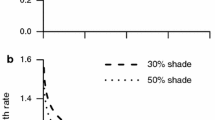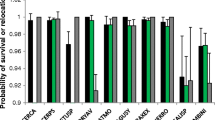Summary
We looked at the relationship between “available area”, as defined by Thiessen polygons around individual plants, and plant size and mortality in even-aged green-house populations of Lapsana communis L. Polygon area was a good predictor of plant weight in these populations. After nine weeks growth, just prior to the onset of self-thinning, the dry weight of plants was directly proportional to the square root of polygon area. After the onset of selfthinning, plant weight appeared to be directly related to polygon area to the 3/2 power. Plants in small polygons were much more likely to die than those in larger areas. Thinning changed the frequency distribution of polygon sizes from highly skewed and unequal to normal and more equal, while inequality in surviving plant sizes did not appear to be affected by thinning.
Similar content being viewed by others
References
Gini C (1912) Variabilita e Mutabilita. Bologna
Harper JL (1961) Approaches to the study of plant competition. In FL Milthorpe (ed), Mechanisms in Biological Competition. Symp Soc Exp Biol 15, pp 1–39
Hickman JC (1979) The basic biology of plant numbers. In: Solbrig OT et al. (eds), Topics in Plant Population Biology Columbia University Press, New York, pp 232–263
Liddle MJ, Budd CSJ, Hutchings MJ (1982) Population dynamics and neighbourhood effects in establishing swards of Festuca rubra. Oikos 38:52–59
Lorenz MO (1905) Methods for measuring the concentration of wealth. J American Stat Assoc 9:209–219
Mack RN, Harper JL (1979) Interference in dune annuals: spatial pattern and neighbourhood effects. J Ecol 65:345–363
Mead R (1966) A relationship between individual plant spacing and yield. Ann Bot 30:301–309
Obeid M, Machin D, Harper JL (1967) Influence of density on plant to plant variations in fiber flax, Linum usitatissimum L. Crop Sci 7:471–473
Rhynsburger D (1973) Analytic deliniation of Thiessen polygons Geog. Analysis 5:133–144
Ross MA, Harper JL (1972) Occupation of biological space during seedling establishment. J Ecol 60:77–88
Sen A (1973) On Economic Inequality. Clarendon, Oxford
Sohn JJ, Policansky D (1977) The costs of reproduction in the mayapple Podophyllum peltatum (Berberidaceae) Ecology 58:1366–1374
Solbrig OT (1981) Studies on the population biology of the genus Viola II. The effect of plant size on fitness in Viola sororia. Evolution 35:1080–1093
Watkinson AR, Lonsdale WM, Firbank LG (1983) A neighbourhood approch to self-thinning. Oecologia (Berlin) 566:381–384
Weiner J (1982) A neighborhood model of annual-plant interference. Ecology 63:1237–1241
Weiner J, Solbrig OT (1984) The meaning and measurement of size hierarchies in plant populations. Oecologia (Berlin) 61: 334–336
White J, Harper JL (1970) Correlated changes in plant size and number in plant populations. J Ecol 58:467–485
Yoda K, Kira T, Ogawa H, Hozumi K (1963) Self thinning in overcrowded pure stands under cultivated and natural conditions. Jour Instit Polytech Osaka City Univ D 14:107–129
Author information
Authors and Affiliations
Rights and permissions
About this article
Cite this article
Mithen, R., Harper, J.L. & Weiner, J. Growth and mortality of individual plants as a function of “available area”. Oecologia 62, 57–60 (1984). https://doi.org/10.1007/BF00377373
Received:
Issue Date:
DOI: https://doi.org/10.1007/BF00377373




